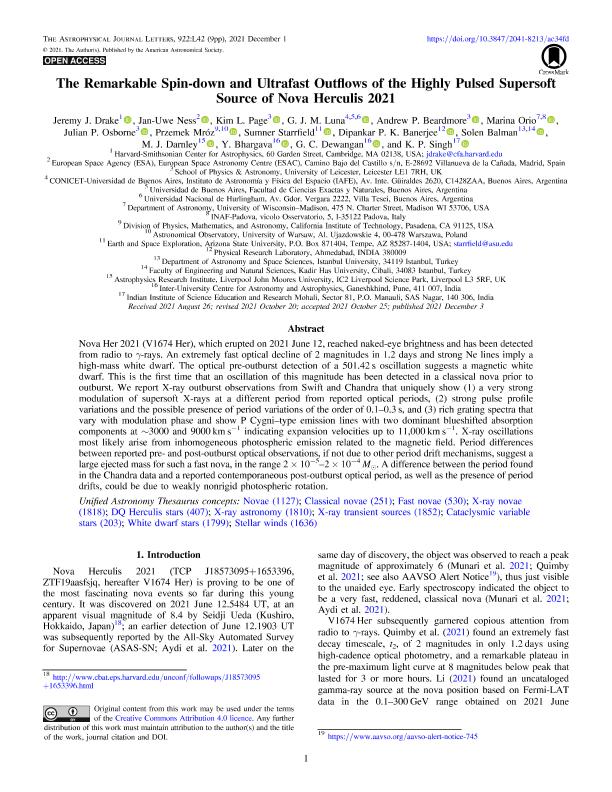Mostrar el registro sencillo del ítem
dc.contributor.author
Drake, Jeremy

dc.contributor.author
Ness, Jan Uwe
dc.contributor.author
Page, Kim L.
dc.contributor.author
Luna, Gerardo Juan Manuel

dc.contributor.author
Beardmore, Andrew P.
dc.contributor.author
Orio, Marina
dc.contributor.author
Osborne, Julian P.
dc.contributor.author
Mróz, Przemek
dc.contributor.author
Starrfield, Sumner
dc.contributor.author
Banerjee, Dipankar P. K.
dc.contributor.author
Balman, Solen
dc.contributor.author
Darnley, Matt J.
dc.contributor.author
Bhargava, Yash
dc.contributor.author
Dewangan, Gulab C.
dc.contributor.author
Singh, Kulinder Pal
dc.date.available
2022-12-26T18:07:20Z
dc.date.issued
2021-12
dc.identifier.citation
Drake, Jeremy; Ness, Jan Uwe; Page, Kim L.; Luna, Gerardo Juan Manuel; Beardmore, Andrew P.; et al.; The Remarkable Spin-down and Ultrafast Outflows of the Highly Pulsed Supersoft Source of Nova Herculis 2021; IOP Publishing; Astrophysical Journal Letters; 922; 2; 12-2021; 1-9
dc.identifier.issn
2041-8205
dc.identifier.uri
http://hdl.handle.net/11336/182382
dc.description.abstract
Nova Her 2021 (V1674 Her), which erupted on 2021 June 12, reached naked-eye brightness and has been detected from radio to γ-rays. An extremely fast optical decline of 2 magnitudes in 1.2 days and strong Ne lines imply a high-mass white dwarf. The optical pre-outburst detection of a 501.42 s oscillation suggests a magnetic white dwarf. This is the first time that an oscillation of this magnitude has been detected in a classical nova prior to outburst. We report X-ray outburst observations from Swift and Chandra that uniquely show (1) a very strong modulation of supersoft X-rays at a different period from reported optical periods, (2) strong pulse profile variations and the possible presence of period variations of the order of 0.1-0.3 s, and (3) rich grating spectra that vary with modulation phase and show P Cygni-type emission lines with two dominant blueshifted absorption components at ∼3000 and 9000 km s-1 indicating expansion velocities up to 11,000 km s-1. X-ray oscillations most likely arise from inhomogeneous photospheric emission related to the magnetic field. Period differences between reported pre- and post-outburst optical observations, if not due to other period drift mechanisms, suggest a large ejected mass for such a fast nova, in the range 2 10-5-2 10-4 M o˙. A difference between the period found in the Chandra data and a reported contemporaneous post-outburst optical period, as well as the presence of period drifts, could be due to weakly nonrigid photospheric rotation.
dc.format
application/pdf
dc.language.iso
eng
dc.publisher
IOP Publishing

dc.rights
info:eu-repo/semantics/openAccess
dc.rights.uri
https://creativecommons.org/licenses/by/2.5/ar/
dc.subject
Novae
dc.subject
Classical novae
dc.subject
Fast novae
dc.subject
X-ray novae
dc.subject.classification
Astronomía

dc.subject.classification
Ciencias Físicas

dc.subject.classification
CIENCIAS NATURALES Y EXACTAS

dc.title
The Remarkable Spin-down and Ultrafast Outflows of the Highly Pulsed Supersoft Source of Nova Herculis 2021
dc.type
info:eu-repo/semantics/article
dc.type
info:ar-repo/semantics/artículo
dc.type
info:eu-repo/semantics/publishedVersion
dc.date.updated
2022-09-23T10:08:19Z
dc.identifier.eissn
2041-8213
dc.journal.volume
922
dc.journal.number
2
dc.journal.pagination
1-9
dc.journal.pais
Reino Unido

dc.journal.ciudad
Londres
dc.description.fil
Fil: Drake, Jeremy. Harvard-Smithsonian Center for Astrophysics; Estados Unidos
dc.description.fil
Fil: Ness, Jan Uwe. Agencia Espacial Europea. XMM-Newton Science Operations Centre; España
dc.description.fil
Fil: Page, Kim L.. University of Leicester; Reino Unido
dc.description.fil
Fil: Luna, Gerardo Juan Manuel. Consejo Nacional de Investigaciones Científicas y Técnicas. Oficina de Coordinación Administrativa Ciudad Universitaria. Instituto de Astronomía y Física del Espacio. - Universidad de Buenos Aires. Facultad de Ciencias Exactas y Naturales. Instituto de Astronomía y Física del Espacio; Argentina. Universidad Nacional de Hurlingham; Argentina
dc.description.fil
Fil: Beardmore, Andrew P.. University of Leicester; Reino Unido
dc.description.fil
Fil: Orio, Marina. Istituto Nazionale di Astrofisica; Italia. University of Wisconsin; Estados Unidos
dc.description.fil
Fil: Osborne, Julian P.. University of Leicester; Reino Unido
dc.description.fil
Fil: Mróz, Przemek. California Institute of Technology; Estados Unidos. Uniwersytet Warszawski; Argentina
dc.description.fil
Fil: Starrfield, Sumner. Arizona State University; Estados Unidos
dc.description.fil
Fil: Banerjee, Dipankar P. K.. Physical Research Laboratory; India
dc.description.fil
Fil: Balman, Solen. Istanbul University; Turquía. Kadir Has University; Turquía
dc.description.fil
Fil: Darnley, Matt J.. Liverpool John Moores University (liverpool John M. University);
dc.description.fil
Fil: Bhargava, Yash. Inter-university Centre For Astronomy And Astrophysics; India
dc.description.fil
Fil: Dewangan, Gulab C.. Inter-university Centre For Astronomy And Astrophysics; India
dc.description.fil
Fil: Singh, Kulinder Pal. Indian Institute Of Science Education And Research Moha; India
dc.journal.title
Astrophysical Journal Letters
dc.relation.alternativeid
info:eu-repo/semantics/altIdentifier/url/https://iopscience.iop.org/article/10.3847/2041-8213/ac34fd
dc.relation.alternativeid
info:eu-repo/semantics/altIdentifier/doi/http://dx.doi.org/10.3847/2041-8213/ac34fd
Archivos asociados
